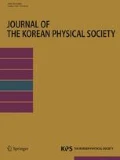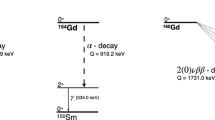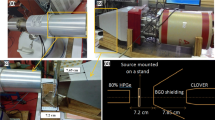Abstract
The Advanced Molybdenum-based Rare process Experiment (AMoRE) searches for neutrino-less double-beta (0νββ) decay of 100Mo in enriched molybdate crystals. The AMoRE crystals must have low levels of radioactive contamination to achieve low background signals with energies near the Q-value of the 100Mo 0νββ decay. To produce low-activity crystals, radioactive contaminants in the raw materials used to form the crystals must be controlled and quantified. 100EnrMoO3 powder, which is enriched in the 100Mo isotope, is of particular interest as it is the source of 100Mo in the crystals. A high-purity germanium detector having 100% relative efficiency, named CC1, is being operated in the Yangyang underground laboratory. Using CC1, we collected a gamma spectrum from a 1.6-kg 100EnrMoO3 powder sample enriched to 96.4% in 100Mo. Activities were analyzed for the isotopes 228Ac, 228Th, 226Ra, and 40K. They are long-lived naturally occurring isotopes that can produce background signals in the region of interest for AMoRE. Activities of both 228Ac and 228Th were < 1.0 mBq/kg at 90% confidence level (C.L.). The activity of 226Ra was measured to be 5.1 ± 0.4 (stat) ± 2.2 (syst) mBq/kg. The 40K activity was found as < 16.4 mBq/kg at 90% C.L.
Similar content being viewed by others
Change history
15 February 2022
An Erratum to this paper has been published: https://doi.org/10.1007/s40042-021-00384-9
References
S. Rahaman et al., Phys. Lett. B 662, 111 (2008).
A. S. Barabash and V. B. Brudanin, Phys. At. Nucl. 74, 312 (2011).
V. Alenkov, arXiv:1512.05957v1 [physics.ins-det] (2015).
H. K. Park, Nucl. Part. Phys. Proc. 273, 2630 (2016).
V. Alenkov et al., Eur. Phys. J. C 79, 791 (2019).
G. B. Kim et al., Adv. High Energy Phys. 2015, 817530 (2015).
G. B. Kim, A 0νββ search using large scintillating crystal with metallic magnetic calorimeter, Ph.D. Dissertation, Seoul National University, 2016.
J. H. So et al., IEEE Trans. Nucl. Sci. 59, 2214 (2012).
J. Y. Lee et al., IEEE Trans. Nucl. Sci. 63, 543 (2016).
J. Y. Lee et al., IEEE Trans. Nucl. Sci. 65, 2041 (2018).
M. H. Lee et al., in Proceedings of the 39th International Conference on High Energy Physics (Seoul, Korea, July 4–11, 2018), PoS (ICHEP2018) 340, 363 (2019).
E. Lee et al., in Proceedings of the 39th International Conference on High Energy Physics (Seoul, Korea, July 4–11, 2018), PoS (ICHEP2018) 340, 809 (2019).
A. Luqman et al., Nucl. Instrum. Methods Phys. Res. A 855, 140 (2017).
O. Gileva et al., J Radioanal. Nucl. Chem. 314, 1695 (2017).
G. Kim, Rare Decay Experiments for 180mTa and208Pb* Using HPGe Detectors, Ph.D. Dissertation, Ewha Womans University, 2019.
JSC isotope, http://www.isotop.ru/en/.
National Nuclear Data Center, https://www.nndc.bnl.gov/nudat2/.
S. Agostinelli et al., Nucl. Instrum. Methods Phys. Res. A 506, 250 (2003).
M. Yoshimori et al., Adv. Space Res. 32, 2691 (2003).
G. F. Knoll, Radiation Detection and Measurement (John Wiley and Sons, New York, 2000), Ed. 3, Chap. 12, p. 413.
E. Sala et al., AIP Conf. Proc. 1672, 120001 (2015).
E. Sala et al., J. Phys.: Conf. Ser. 718, 062050 (2016).
A. N. Annenkov et al., Nucl. Instrum. Methods Phys. Res. A 584, 334 (2008).
S. Y. Park et al., in Proceedings of the 39th International Conference on High Energy Physics (Seoul, Korea, July 4–11, 2018), PoS (ICHEP2018) 340, 783 (2019).
Acknowledgments
Thisworkwas supported by the Institute forBasic Science (IBS) funded by the Ministry of Science and Technology, Korea (Grant id: IBS-R016-D1).
Author information
Authors and Affiliations
Corresponding author
About this article
Cite this article
Park, Sy., Hahn, I., Kang, W.G. et al. Measurement of the Background Activities of a 100Mo-enriched Powder Sample for an AMoRE Crystal Material by Using a Single High-Purity Germanium Detector. J. Korean Phys. Soc. 76, 1060–1066 (2020). https://doi.org/10.3938/jkps.76.1060
Received:
Revised:
Accepted:
Published:
Issue Date:
DOI: https://doi.org/10.3938/jkps.76.1060




